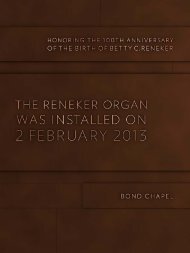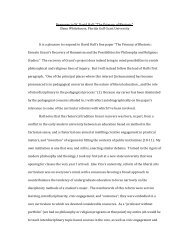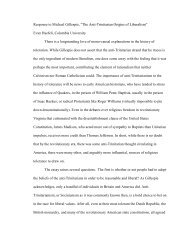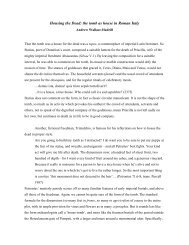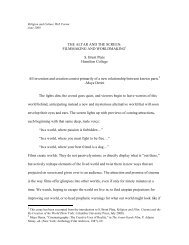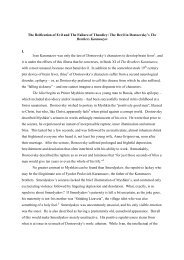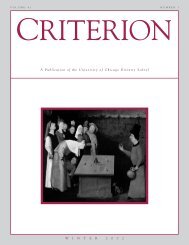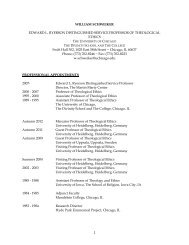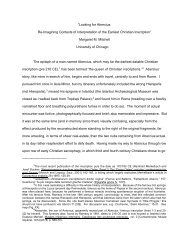Gregory Thaumaturgus - Divinity School - University of Chicago
Gregory Thaumaturgus - Divinity School - University of Chicago
Gregory Thaumaturgus - Divinity School - University of Chicago
Create successful ePaper yourself
Turn your PDF publications into a flip-book with our unique Google optimized e-Paper software.
Bios’s main appeal from a pedagogical or catechetical standpoint is that embodied virtue thus preserved in<br />
text can be imitated and re-embodied by those who read about it. The fourth-century Cappadocian Father<br />
<strong>Gregory</strong> <strong>of</strong> Nyssa has three biographical narratives that work with the concept <strong>of</strong> embodied virtue in order<br />
to present virtuous exemplars to reading and listening audiences: The Life <strong>of</strong> Moses, a re-telling and allegorical<br />
interpretation <strong>of</strong> biblical narratives about the lawgiver; The Life <strong>of</strong> Macrina, an encomiastic account <strong>of</strong><br />
<strong>Gregory</strong>’s oldest sister’s birth, upbringing, admirable life, and noble death; and The Life <strong>of</strong> <strong>Gregory</strong><br />
<strong>Thaumaturgus</strong>, a lengthy oratorical presentation <strong>of</strong> <strong>Gregory</strong> the Wonderworker’s amazing feats and<br />
theological teachings. In each <strong>of</strong> these bioi, Nyssen describes, praises, allegorizes, and sometimes exploits his<br />
subjects’ physical bodies as sites through which readers can discern the subjects’ internal strengths. The<br />
works’ prefaces disclose <strong>Gregory</strong>’s didactic aims: each text not only illuminates but also recommends its<br />
subjects’ virtues to the audience as worthy <strong>of</strong> imitation. A close reading <strong>of</strong> the bath demon episode in the<br />
Life <strong>of</strong> <strong>Gregory</strong> <strong>Thaumaturgus</strong> (VGT) provides us with an opportunity to examine <strong>Gregory</strong> <strong>of</strong> Nyssa’s complex<br />
and multi-layered process <strong>of</strong> characterization, a crucial tool for narrating imitable embodied virtue.<br />
In this paper we will examine the episode from three perspectives, which we might think <strong>of</strong> as<br />
expanding concentric circles. First, tightly focused on the events <strong>of</strong> the narrative itself, we will see that<br />
<strong>Gregory</strong>’s use <strong>of</strong> detailed physical description has a variety <strong>of</strong> effects: it creates a vivid (and frankly<br />
frightening) sense <strong>of</strong> the narrative setting and atmosphere; it evokes the presence <strong>of</strong> his subject the<br />
Wonderworker even when this figure is not “on stage”; and it presents a manifestation <strong>of</strong> spiritual power<br />
that is decidedly material and expressed in the practitioner’s physical behaviors. This power can be<br />
perceived with the senses, recorded in narrative form, then revisited and re-experienced by reading and<br />
listening audiences. This observation about the repeated evocation <strong>of</strong> physical, sense experience through<br />
text leads us to the second critical perspective, examining the potential effects <strong>of</strong> characterization techniques<br />
on an ideal audience. We can trace the way <strong>Gregory</strong> tries to carefully control his audience’s vantage point<br />
and condition reader responses: how do characters on the level <strong>of</strong> the narrative react to the miraculous



